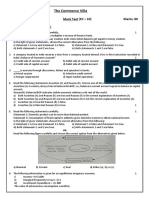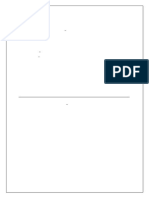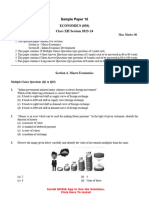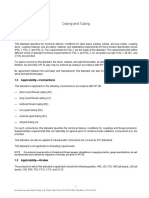0 ratings0% found this document useful (0 votes)
13 viewsXII Economics QP
XII Economics QP
Uploaded by
UJCopyright:
© All Rights Reserved
Available Formats
Download as DOCX, PDF, TXT or read online from Scribd
XII Economics QP
XII Economics QP
Uploaded by
UJ0 ratings0% found this document useful (0 votes)
13 views4 pagesCopyright
© © All Rights Reserved
Available Formats
DOCX, PDF, TXT or read online from Scribd
Share this document
Did you find this document useful?
Is this content inappropriate?
Copyright:
© All Rights Reserved
Available Formats
Download as DOCX, PDF, TXT or read online from Scribd
Download as docx, pdf, or txt
0 ratings0% found this document useful (0 votes)
13 views4 pagesXII Economics QP
XII Economics QP
Uploaded by
UJCopyright:
© All Rights Reserved
Available Formats
Download as DOCX, PDF, TXT or read online from Scribd
Download as docx, pdf, or txt
You are on page 1of 4
ASHA PUBLIC SCHOOL
PRE BOARD EXAM- 1
Class – XII
SUBJECT- ECONOMICS
Time allowed: 3 hours SET- B Maximum Marks: 80
General Instructions:
(i) This question paper contains two sections:
Section A- Introductory Macroeconomics
Section B- Indian Economic Development
(ii) This paper contains 20 Multiple Choice Questions type questions of 1 mark each.
(iii) This paper contains 4 Short Answer Question type questions of 3 marks each to be answered in 60 to 80 words.
(iv)This paper contains 6 Short Answer Question type questions of 4 marks each to be answered in 80 to 100 words.
(v) This paper contains 4 Long Answer Question type questions of 6 marks each to be answered in 100 to 150 words.
Q.No PART-A (INTRODUCTORY MACROECONOMCS) Marks
1. Read the following statements - Assertion (A) and Reason (R). Choose one of the correct alternatives 1
given below:
Assertion (A): Fiscal deficit indicates the total borrowing requirements of the government.
Reason (R): Government mainly borrow from the RBI to meet its fiscal deficit.
Alternatives:
(a) Both Assertion (A) and Reason (R) are true and Reason (R) is the correct explanation of Assertion (A)
(b) Both Assertion (A) and Reason (R) are true and Reason (R) is not the correct explanation of Assertion
(A)
(c) Assertion (A) is true but Reason (R) is false.
(d) Assertion (A) is false but Reason (R) is true.
2. Who is the ‘Lender of the last resort’ in the banking structure of India? 1
(a) Axis bank
(b) State bank of India
(c) Reserve bank of India
(d) NABARD
3 Increase in the value of domestic currency by the government is called- 1
(a) Appreciation (b) Devaluation
(c) Revaluation (d) Depreciation
4 Read the following statements - Assertion (A) and Reason (R). Choose one of the correct alternatives 1
given below:
Assertion (A): At Break -even point, Consumption is equal to national Income.
Reason (R): APC falls continuously with increase in income as proportion of income spent on
consumption keeps on decreasing.
(a) Both Assertion (A) and Reason (R) are true and Reason (R) is the correct explanation of Assertion (A)
(b) Both Assertion (A) and Reason (R) are true and Reason (R) is not the correct explanation of Assertion
(A
(c) Assertion (A) is true but Reason (R) is false.
(d) Assertion (A) is false but Reason (R) is true.
5. Statement 1: Value of MPC and MPS varies between 0 and 1. 1
Statement 2 : The sum of MPC and MPS is equal to one.
(a) Statement 1 is true and statement 2 is false (b) Statement 1 is false and statement 2 is true
(c) Both statements 1 and 2 are true (d) Both statements 1 and 2 are false.
OR
Statement 1: The equilibrium level of income in an economy is determined when aggregate demand is
equal to aggregate supply.
Statement 2: Aggregate supply is depicted by a 45 degree line.
(a) Statement 1 is true and statement 2 is false (b) Statement 1 is false and statement 2 is true
(c) Both statement 1 and 2 is true (d) Both statement 1 and 2 are false.
6. Borrowing by government is- 1
(a) Revenue Expenditure (c) Capital expenditure
(b) Capital receipts (d) Revenue receipts
OR
Identify the tax whose burden can be shifted
(a) Income tax (c) goods and services tax
(b)Corporate tax (d) None of these
Page 1 of 4
7. Policy of surplus budget during inflation is a part of which objectives of government budget 1
(a) Economic stability (b) Reallocation of resources
(c) Reducing regional disparities (d) Economic growth
8. Suppose in an economy, the initial deposits of ₹ 1000 crores lead to the creation of total deposits 1
worth ₹ 10000 crores.
Under the given situation the value of legal reserve ratio would be
(a) 0.4 (b) 1 (c) 10 (d) 0.01
9. Read the following statements - Assertion (A) and Reason (R). Choose one of the correct alternatives
given below:
Assertion (A): Commercial banks contribute to quantum of money supply in the economy through credit
creation.
Reason (R): Commercial banks have the note issuing authority.
Alternatives:
(a) Both Assertion (A) and Reason (R) are true and Reason (R) is the correct explanation of Assertion (A)
(b) Both Assertion (A) and Reason (R) are true and Reason (R) is not the correct explanation of Assertion
(c) Assertion (A) is true but Reason (R) is false.
(d) Assertion (A) is false but Reason (R) is true.
10. Under the Balance of Payments structure of a nation, the two main categories of accounts for the 1
classification of the transactions are ……..and………
(Fill up the blank with correct alternative)
(i) current account (ii) unilateral transfer account
(iii) capital account (iv) loan account
Identify the correct alternatives from the following:
Alternatives:
(a) i and ii (b) i and iii
(c) iii and iv (d) iv and i
11. What is investment multiplier? Explain its working using a suitable numerical example. 3
12. Explain the objectives of reallocation of resources and redistribution of income and wealth in a 3
government budget.
OR
How are capital expenditure different from revenue expenditure? Discuss briefly.
13. Define the Money and explain its major functions. 4
OR
Explain the following function of central bank-
Banker to the government (2) Banker’s Bank
14. Distinguish between final goods and intermediate goods. Can sugar be intermediate goods? Give reasons 4
for your answer.
15. Explain the distinction between the flexible exchange rate and the managed floating exchange rate. 4
16. Calculate (a) Gross domestic product at market price and (b) Factor income from abroad from the 3+3
following information-
S.N Particulars In crore
1. Interest 400
2. Rent 300
3. Exports 40
4. Gross national product at factor cost 2800
5. Profits 500
6. Compensation of employees 1500
7. Gross fixed capital formation 700
8. Net indirect taxes 250
9. Net current transfer from rest of the world 90
10 Change in stock 50
11. Net domestic capital formation 650
12. Factor income to abroad 120
OR
Whether the following items will be included in National income? Give reason for your answer.
Gain from the sale of shares
Gift from abroad
Interest received on loan given by government.
Retained earning of residents companies from abroad.
Page 2 of 4
17. Derived consumption curve from saving curve. Use schedule and figure. Write-down steps of 06
construction.
PART-B (INDIAN ECONOMIC DEVELOPMENT)
18 Reforms were introduce …………….in China and in ……………..Pakistan. 1
(a) 1978, 1988 (b) 1998, 1991
(c) 1978, 1991 (d) 1988,1978
19 The Great leap Forward Campaign was initiated in China in: 1
(a) 1978 (b) 1958 (c) 1965 (d) 1979
OR
In China Commune system related to……………….. sector
(a) Agriculture (b) Industry (c) Service (d) all of the above
20. Read the statement carefully: 1
Statement 1: All the three countries (India China Pakistan) introduced the economic reforms in the same
year.
Statement 2: China’s annual growth rate of population is more than India and Pakistan.
(a) Statement 1 is true and statement 2 is false
(b) Statement 1 is false and statement 2 is true
(c) Both statements 1 and 2 are true
(d) Both statements 1 and 2 are false.
21. Which types of economics system is followed in China? 1
(a) Capitalist Economy (b) Socialist Economy
(c) Mixed Economy (d) None of these
22. Worker who own and operate an enterprise to earn their livelihood are known as- 1
(a) Wage employed (b) Causal Employed
(c) Self-employed (d) none of these
OR
Unemployed people is calculated as-
(a) Laboure force -work force (b) Laboure force+Work force
(c) work force - laboure force (d) None of these
23. Read the following statements - Assertion (A) and Reason (R). Choose one of the correct alternatives 1
given below:
Assertion (A): Under the financial sector reforms, financial sector was allowed to take decision on after
consulting RBI.
Reason (R): The role of RBI was reduced from regulator to facilitator of financial sector.
Alternatives:
(a) Both Assertion (A) and Reason (R) are true and Reason (R) is the correct explanation of Assertion (A)
(b) Both Assertion (A) and Reason (R) are true and Reason (R) is not the correct explanation of Assertion (
(c) Assertion (A) is true but Reason (R) is false.
(d) Assertion (A) is false but Reason (R) is true.
24. Read the following statements - Assertion (A) and Reason (R). Choose one of the correct alternatives 1
given below:
Assertion (A): The infrastructure facilities during British rule were highly developed.
Reason (R): The main aim behind infrastructure development was to serve colonial interest.
(a) Both Assertion (A) and Reason (R) are true and Reason (R) is the correct explanation of Assertion (A).
(b) Both Assertion (A) and Reason (R) are true and Reason (R) is not the correct explanation of Assertion
(A).
(c) Assertion (A) is true but Reason (R) is false.
(d) Assertion (A) is false but Reason (R) is true.
25. Read the statement carefully: 1
Statement1: Rural development includes only agricultural development.
Statement2: Rural development aim at improving the economic and social condition of the people living in
villages.
(a) Statement 1 is true and statement 2 is false
(b) Statement 1 is false and statement 2 is true
(c) Both statement 1 and 2 is true
(d) Both statement 1 and 2 are false.
26. Read the statement carefully: 1
Statement 1: According to Industrial policy resolution 1956 the industries were classified into three
categories.
Statement 2: Schedule A comprised of industries which would be exclusively owned by the state.
(a) Statement 1 is true and statement 2 is false
Page 3 of 4
(b) Statement 1 is false and statement 2 is true
(c) Both statement 1 and 2 is true
(d) Both statement 1 and 2 are false.
27. The ratio of labour force to total population is termed as? 1
(a)Labour force participation ratio (b) Work force
(c)Both (a) and (b) (d) Neither (a) nor (b)
28 What do you mean by human capital formation? Explain the role of human capital formation in economic 3
development.
OR
Education is considered an important input for the Development of the nation. How?
29 What do you mean by demonetisation? State the features of demonetisation. 3
30 Sector Contribution to GVA Distribution of Workforce 4
India China Pakistan India China Pakistan
Agriculture 16 7 24 43 26 41
Industry 30 41 19 25 28 24
Service 54 52 57 32 46 35
Total 100 100 100 100 100 100
With the help of given schedule compare distribution of workforce and contribution to GCVA between
India China and Pakistan.
31 Discuss the various institutional and non-institutional sources of rural credit. 4
OR
What is agricultural marketing? What are the problems faced by Indian farmers in marketing of their
agriculture produce.
32 Following table show the trends of employment in different sectors. Discuss the role of different sectors in
employment generation in given years. 4
Sector 1972-73 1993-94 2011-12 2017-18
Primary Sector 74.3 64 48.9 44.6
Secondary sector 10.9 16 24.3 24.4
Tertiary Sector 14.8 20 26.8 31
Total 100 100 100 100
33 (a) If the rate of resource extraction exceeds the rate of regeneration, it leads to reduction in carrying
capacity of the environment.” Discuss the rationale of the given statement with valid reasons.
(b) What do you mean by global warming? Why does it occur? How can it adversely affect the earth?
OR 3+3
(A) “Rural economic development is essential for Indian Economic development”. Do you agree with the
given statement? Support your answer with valid reasons.
(B) What is meant by organic farming? Discuss its benefits.
34 Read the following hypothetical text and answer the given questions: 3+3
The performance of Indian economy during the period of first seven five year plans (1950-1990) was
satisfactory if not very impressive. On the eve of independence, India was an industrially backward country,
but during this period of first seven plans our industries became far more diversified, with the stress being
laid on the public investments in the industrial sector. The policy of import substitution led to protection of
the domestic industries against the foreign producers but we failed to promote a strong export surplus.
Although public sector expanded to a large extent but it could not bring desired level of improvement in the
secondary sector. Excessive government regulations prevented the natural trajectory of growth of
entrepreneurship as there was no competition, no innovation and no modernization on the front of the
industrial sector. Many Public Sector Undertakings (PSU’s) incurred huge losses due to operational
inefficiencies, red-tapism, poor technology and other similar reasons. These PSU’s continued to function
because it was difficult to close a government undertaking even it is a drain on country’s limited resources.
On the Agricultural front, due to the measures taken under the Green Revolution, India more or less became
self-sufficient in the production of food grains. So the needs for reform of economic policy were widely felt
in the context of changing global economic scenario to achieve desired growth in the country.
(a) What do you mean by import substitution? How it helpful in rapid growth of domestic industries?
(b) Discuss any two reasons for the poor performance of industrial sector before economic reform .
Page 4 of 4
You might also like
- Series 65 Exam Practice Question Workbook: 700+ Comprehensive Practice Questions (2024 Edition)From EverandSeries 65 Exam Practice Question Workbook: 700+ Comprehensive Practice Questions (2024 Edition)No ratings yet
- Heywood Chapter 3 NotesDocument7 pagesHeywood Chapter 3 NotesCath ;100% (2)
- Job Stress SPSS AnalysisDocument7 pagesJob Stress SPSS AnalysisSelva RajanNo ratings yet
- gx160 HondaDocument1 pagegx160 Hondamatt1985200967% (3)
- Economics Question Paper Class 12 Preboards Sunbeam SchoolDocument6 pagesEconomics Question Paper Class 12 Preboards Sunbeam Schoolsuchitasingh1106No ratings yet
- ISWK XII Economics (030) QP & MS REHEARSAL 1 (23-24)Document15 pagesISWK XII Economics (030) QP & MS REHEARSAL 1 (23-24)hanaNo ratings yet
- Eco QP 1 CSSC WDocument8 pagesEco QP 1 CSSC Wdianaprince2006No ratings yet
- ECONOMICSDocument125 pagesECONOMICSpriyanshi.bansal25No ratings yet
- XII Economics Guess Paper - 1Document5 pagesXII Economics Guess Paper - 1kawaljeetsingh121666No ratings yet
- XII ECONOMICS QP Pre Board IIDocument4 pagesXII ECONOMICS QP Pre Board IIShivansh JaiswalNo ratings yet
- west Chennai sahodaya cluster SET-3 QP ECODocument8 pageswest Chennai sahodaya cluster SET-3 QP ECOanjanab1810No ratings yet
- Oswal Gurukul Ms 2.DocDocument13 pagesOswal Gurukul Ms 2.Docsweetykaur2804No ratings yet
- Test 10 Macro Full CourseDocument4 pagesTest 10 Macro Full CourseanxyisminecraftNo ratings yet
- west Chennai sahodaya cluster SET -2 QP ECODocument9 pageswest Chennai sahodaya cluster SET -2 QP ECOanjanab1810No ratings yet
- G3P_Eco_2Document9 pagesG3P_Eco_2sumangorain111No ratings yet
- XII Economics MS Set 2Document11 pagesXII Economics MS Set 2tayalparth4No ratings yet
- Economics Sample Paper 1Document8 pagesEconomics Sample Paper 1Rijvan AggarwalNo ratings yet
- XII PB-1 Economics (24.11.2023)Document6 pagesXII PB-1 Economics (24.11.2023)divyanshi.24088No ratings yet
- Economics question 2Document7 pagesEconomics question 2nihilmari196No ratings yet
- DOC-20250103-WA0020.Document6 pagesDOC-20250103-WA0020.pp4414233No ratings yet
- Class 12 CBSE Economics Sample PaperDocument8 pagesClass 12 CBSE Economics Sample Paperyazhinirekha4444No ratings yet
- west Chennai sahodaya CLUSTER SET- 1 QP ECODocument9 pageswest Chennai sahodaya CLUSTER SET- 1 QP ECOanjanab1810No ratings yet
- XII QP Economics CPB 2k24Document8 pagesXII QP Economics CPB 2k24commerce12onlineclassesNo ratings yet
- Economics (030) XII CBSE Oman Gulf Sahodaya (CPBE) QP & MS (23-24)Document15 pagesEconomics (030) XII CBSE Oman Gulf Sahodaya (CPBE) QP & MS (23-24)naasifsinfo22No ratings yet
- Class 12 Ut-1 Question Paper EcoDocument4 pagesClass 12 Ut-1 Question Paper EcoAFRAH JALEELANo ratings yet
- XII Economics Guess Paper - 2Document5 pagesXII Economics Guess Paper - 2kawaljeetsingh121666No ratings yet
- The Commerce Villa: Time: 3 Hours Mock Test (EC - 10) Marks: 80 Section A (Macro Economics)Document15 pagesThe Commerce Villa: Time: 3 Hours Mock Test (EC - 10) Marks: 80 Section A (Macro Economics)Shreyas PremiumNo ratings yet
- cbleecpu15Document7 pagescbleecpu15bhavitchopra07No ratings yet
- ECONOMICS030QP-SET2_56e39d29c8404c42b17f4a37d7a45a1a_40336Document9 pagesECONOMICS030QP-SET2_56e39d29c8404c42b17f4a37d7a45a1a_40336kaid30306No ratings yet
- Xii Preboard Set A (23 24) PDFDocument9 pagesXii Preboard Set A (23 24) PDFZehra ZainviNo ratings yet
- Economics Xii Kvs Sqp-1 by Cuet & Cbse CoterieDocument10 pagesEconomics Xii Kvs Sqp-1 by Cuet & Cbse CoteriesamyakkatariaamityNo ratings yet
- cbse pre board new 5 fullDocument8 pagescbse pre board new 5 fullRAVI KABRANo ratings yet
- Preboard 3 EcoDocument8 pagesPreboard 3 EcoSuganthi VNo ratings yet
- Practice Paper 1 Dt.14.12.24Document9 pagesPractice Paper 1 Dt.14.12.24khushnoorkaur2007No ratings yet
- Cbse Class 12 Economics Question Paper Set 1 58 4-1-2023Document29 pagesCbse Class 12 Economics Question Paper Set 1 58 4-1-2023ahmadsaifa450No ratings yet
- cbleecpu12Document8 pagescbleecpu12bhavitchopra07No ratings yet
- Preboard EcoDocument5 pagesPreboard EcoPuja BhardwajNo ratings yet
- Sample Paper Economics Class 12Document5 pagesSample Paper Economics Class 12onlybooks.sakshamNo ratings yet
- This Question Paper Contains Two PartsDocument17 pagesThis Question Paper Contains Two PartsRavikumar BalasubramanianNo ratings yet
- Class 12 - Economics (030) - Ce - Qp - Set 1Document8 pagesClass 12 - Economics (030) - Ce - Qp - Set 1saisurya2517100% (1)
- Cbse Class 12 Economics Question Paper Set 1 58 2-1-2023Document38 pagesCbse Class 12 Economics Question Paper Set 1 58 2-1-2023recruitmentinfo86No ratings yet
- 3 ECODocument9 pages3 ECOjoeljoby11947No ratings yet
- cbse pre board 4Document8 pagescbse pre board 4RAVI KABRANo ratings yet
- 1..QP CLASS XII ECO Common Board 2022 23Document11 pages1..QP CLASS XII ECO Common Board 2022 23hanaNo ratings yet
- Eco Pre Board 1 Set A 22-23Document8 pagesEco Pre Board 1 Set A 22-23ananya sharmaNo ratings yet
- EconomicsDocument113 pagesEconomicsdevanshsoni4116No ratings yet
- MODEL QP -1 FINALDocument22 pagesMODEL QP -1 FINALvijayendra0393No ratings yet
- EC Sample Paper 16 UnsolvedDocument7 pagesEC Sample Paper 16 UnsolvedMilan TomarNo ratings yet
- (8) 12th Economics QpDocument7 pages(8) 12th Economics QpdakshikakowalNo ratings yet
- Economics Pre BoardDocument8 pagesEconomics Pre BoardSourabh TiwariNo ratings yet
- Cbleecpu 12Document8 pagesCbleecpu 12Pubg GokrNo ratings yet
- Class 12 CBSE Sample Paper EconomicsDocument8 pagesClass 12 CBSE Sample Paper Economicsyazhinirekha4444No ratings yet
- Economics Prelims Set-1Document10 pagesEconomics Prelims Set-1nahidk1819No ratings yet
- Class 12 CBSE Economics Sample Paper 2023Document8 pagesClass 12 CBSE Economics Sample Paper 2023yazhinirekha4444No ratings yet
- shailjain_1_474689 (1)Document18 pagesshailjain_1_474689 (1)naviii0711No ratings yet
- Class 12 - ECONOMICS (030) - CE - QP - SET 2Document8 pagesClass 12 - ECONOMICS (030) - CE - QP - SET 2saisurya2517100% (1)
- MS XII Eco Sample SEL23-24Document20 pagesMS XII Eco Sample SEL23-24kiyo.taka.k77No ratings yet
- 7.economics - Class 12 - Common Pre - Board-2023-Question-PaperDocument10 pages7.economics - Class 12 - Common Pre - Board-2023-Question-Papercommerce12onlineclassesNo ratings yet
- 11th Class Question Paper AnnualDocument4 pages11th Class Question Paper Annualvanita aroraNo ratings yet
- 3845372-ECONOMICS QUESTION PAPER ASSESSMENT IDocument10 pages3845372-ECONOMICS QUESTION PAPER ASSESSMENT ImohammedaflalhiNo ratings yet
- cbleecpu01Document9 pagescbleecpu01nathaniaashiNo ratings yet
- Eco sqp2Document5 pagesEco sqp2D A Dania MargaretNo ratings yet
- Pb23eco02 QPDocument7 pagesPb23eco02 QPAfiya NazimNo ratings yet
- Biology UT- II Class XIDocument3 pagesBiology UT- II Class XIUJNo ratings yet
- Half yearly Class 10Document5 pagesHalf yearly Class 10UJNo ratings yet
- TEST LIFE PROCESSDocument2 pagesTEST LIFE PROCESSUJNo ratings yet
- SCIENCE PORTFOLIO FRONTDocument4 pagesSCIENCE PORTFOLIO FRONTUJNo ratings yet
- Biology Short NotesDocument37 pagesBiology Short NotesUJNo ratings yet
- 89 Circular National Summit 2024 16102024Document3 pages89 Circular National Summit 2024 16102024UJNo ratings yet
- Part 1Document58 pagesPart 1UJNo ratings yet
- Land Prep Lesson PlanDocument3 pagesLand Prep Lesson PlanreginamaerealNo ratings yet
- Pro Stores Store Admin FullDocument363 pagesPro Stores Store Admin FullAnalette AbesamisNo ratings yet
- 1 Pdfsam Scream Final ScriptDocument25 pages1 Pdfsam Scream Final ScriptshaudtddydkNo ratings yet
- Statistical Applications - Practical-RecordDocument31 pagesStatistical Applications - Practical-RecordGanga RkoNo ratings yet
- Module 7 - Theory of Separation of PowersDocument24 pagesModule 7 - Theory of Separation of PowersChristian GeromianoNo ratings yet
- NoticeDocument13 pagesNoticeAnonymous lhXJtaA100% (1)
- Csc443 Test 2Document13 pagesCsc443 Test 2muhammad ali imranNo ratings yet
- Hospitality Services Team Decision Making Event Participant InstructionsDocument5 pagesHospitality Services Team Decision Making Event Participant InstructionsaoifepucchioNo ratings yet
- 3rd Year 1st SemesterDocument11 pages3rd Year 1st SemesterSalma SultanaNo ratings yet
- Vproxy GuideDocument368 pagesVproxy GuidenagaratnareddyNo ratings yet
- Bmee212l Quality-Control-And-Improvement TH 1.0 70 Bmee212lDocument2 pagesBmee212l Quality-Control-And-Improvement TH 1.0 70 Bmee212lSrinivasan NarayananNo ratings yet
- Patents and Declarations 3 of 3Document126 pagesPatents and Declarations 3 of 3abdNo ratings yet
- Evaluation of Imf & Ibrd 22 SlidesDocument22 pagesEvaluation of Imf & Ibrd 22 SlidesvmktptNo ratings yet
- عبدالله بديه باسمDocument9 pagesعبدالله بديه باسمakramNo ratings yet
- Msds of Propylene GlycolDocument6 pagesMsds of Propylene GlycolЯна ЗубрицькаNo ratings yet
- Credit Rating PPT by WWW - Modelexam.in.Document35 pagesCredit Rating PPT by WWW - Modelexam.in.Thiagarajan SrinivasanNo ratings yet
- How To Do A Literature Review Helen AveyardDocument5 pagesHow To Do A Literature Review Helen Aveyardc5pnw26s100% (1)
- Broadcast: (Radio, Television and Film)Document19 pagesBroadcast: (Radio, Television and Film)Kim CruzNo ratings yet
- Filiut v. Applegate Et Al - Document No. 14Document7 pagesFiliut v. Applegate Et Al - Document No. 14Justia.comNo ratings yet
- Operation Management Workbook For StudentsDocument230 pagesOperation Management Workbook For StudentsVignesh Anguraj91% (11)
- Systems Theory ModelDocument3 pagesSystems Theory ModelFiffy Azza TandangNo ratings yet
- OBS - Online Banking System SynopsisDocument2 pagesOBS - Online Banking System SynopsisMajidNo ratings yet
- Tubing and CasingDocument10 pagesTubing and CasingEnd LabNo ratings yet
- 1901 ResumeDocument2 pages1901 Resumenaga lakshmiNo ratings yet
- IRC Method of Design of Flexible PavementsDocument12 pagesIRC Method of Design of Flexible PavementsZohaibShoukatBalochNo ratings yet
- Digital Fluency VJDocument27 pagesDigital Fluency VJsushma harishNo ratings yet
- Cancellation of Deed of Absolute SaleDocument2 pagesCancellation of Deed of Absolute Salejudith de leon100% (3)
































































































